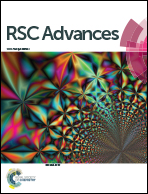Preparation, physicochemical properties and in vitro bioactivity of hierarchically porous bioactive glass scaffolds
Abstract
Exploring bioactive scaffolds with the desired architecture and high osteogenic capacity has been a challenging issue for biomaterials and bone tissue engineering. Herein, a hierarchically porous bioactive glass scaffold (noted as YMBG) has been prepared by using P123, yeast cells and polyurethane sponges as templates. This synthesis strategy created high porosity scaffolds with interconnected macropores (300–500 μm), well-ordered mesopores (∼5 nm) and mid-level pores (20 nm to 2 μm). The utilization of yeast cells as a midpore biotemplate in the scaffolds significantly promoted the crystallization and improved their mechanical strengths. In addition, the prepared scaffolds could support attachment and proliferation of BMSCs, and more importantly, significantly improved the expression of bone-related genes (Runx2, OCN, Col I and BMP2). The results suggest that the novel bioactive glass scaffolds with widely-distributed porous structures, which can be employed as an effective carrier for a variety of therapeutic molecules and tissue cells, are expected to be a promising biomaterial for bone regeneration and tissue engineering.


 Please wait while we load your content...
Please wait while we load your content...